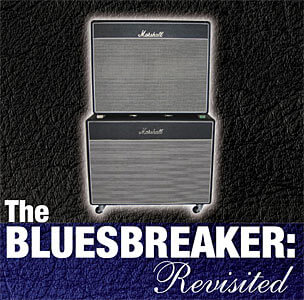
If you want to nail Clapton’s tone, a crucial part of the equation is the amplifier. With a little ingenuity, John Wiley shows you how to turn your reissue Bluesbreaker combo into the real deal.
A unique distinction of early Marshall amplifiers is that none of them within the same model line sound exactly alike. Partly attributable to founder Jim Marshall’s penchant for working with budding British musicians and working many of their suggestions into his designs, and partly due to the difficulties of locating reliable parts suppliers, Marshall’s early designs each had their own personality. For instance, Marshall’s Model 1962 combo was, itself, an ordinary amplifier; however, one particular Model 1962 used by Eric Clapton with John Mayall and the Bluesbreakers had such a revolutionary tone that it created a new sound in the still-young world of rock n’ roll.
In 1965, Clapton found himself the featured guitarist in John Mayall and the Bluesbreakers. Armed with a 1960 Gibson Les Paul and the Marshall Model 1962 combo amplifier, he single-handedly discovered a combination of guitar and amp that produced an extraordinary howl — Clapton achieved his trademark sound by playing the amplifier at full volume. The sound was full-bodied, authoritative, but not overly distorted; it easily cut through the other band instruments. The sustain was pure, the treble notes sang and the bass registers exhibited a “throaty” bottom. At such high volumes, the amp was prone to feeding back, and this provided an awesome effect to the overall sound.
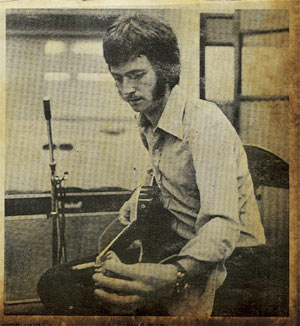
This image, from the Beano LP, shows Clapton tuning up, with his Model 1962 in the background.
The blistering tone was captured on vinyl and released to an unwitting public as John Mayall and the Bluesbreakers with Eric Clapton; also known as the “Beano” album, it quickly shot to number six on the British charts, even amongst the din of other popular British and American pop groups such as the Beatles, the Animals, the Rolling Stones and the Beach Boys. That LP’s impact soon spread to America and abroad, inspiring legions of new guitarists around the world — especially influencing musical rebels in the United States. Clapton’s playing style, combined with a ferocious amplified tone, seemed to inject a new and exciting dimension into the young blues-rock genre. But none of this could have happened without the small British amp company, Vox. Models like the AC30 would provide the “British Invasion” with its unique sound, and convinced Marshall to build a compact amplifier for his new company; the initial development of Marshall’s first combo took place in early 1964. In a 2003 interview with Musician’s Hotline magazine, he claimed the Model 1962 was built at the request of Eric Clapton. “Eric used to practice in my shop and he was one of the first guitarists to ask me to build a combo,” Marshall recalled. “He wanted one so it would be easy for him to put the whole thing in the boot [trunk] of his car.”
Unfortunately, that Model 1962 disappeared, with Clapton himself unsure of what became of it; years later, it would become known as the holy grail of combos. Although those early combos had great tone, no two sound exactly the same. Two decades later, the Marshall reissue would sound nothing like it at all.
The Reissue
For many of us, the year 1990 brought an answer to one of our greatest wishes: the Marshall Model 1962 2×12 combo was finally reissued. The idea had apparently been in the works for quite some time, as evidenced by this author’s correspondence to a Marshall factory director, Keith Carnall in the late months of 1984. Carnall’s reply stated, “We have thought many times about running a ‘vintage special,’ with valve rectification and all the other old goodies… let us just say for now that it is an idea that we will continue to work around and perhaps you will get your wish granted.” Although Clapton was not aware of the amp being reissued, Marshall christened it the “Bluesbreaker,” in his honor. When asked in a 1989 Guitar World interview he replied, “Did they really? How sweet. I didn’t even know that. How does it sound?” Marshall simultaneously introduced the Bluesbreaker and the JTM45 in 1990, along with the new JCM900 series.
At a cursory first glance, Marshall did an outstanding job recreating the Bluesbreaker, as it externally resembled the original with the distinctive and elegant Marshall styling. Just like the original, it was rated at 45 watts and came with two Celestion speakers. The cabinet dimensions measured 29.13″ wide by 23.62″ high by 9.25″ deep, and black vintage Tolex coupled with a vintage-style Bluesbreaker grill cloth completed the package. Electronically, the 1989 reissue used two 6L6 vacuum tubes for power, three ECC83 (12AX7) preamp tubes and one GZ34 rectifier tube. In 1993, Marshall replaced the 6L6s with 5881 vacuum tubes. Tonally, the Bluesbreaker reissue had a unique and fine sound of its own. It produced varying degrees of that buttery smooth sustain, while retaining that traditional Marshall crunch.
The following is a listing of the basic differences between the original Model 1962 and the Model 1962 “Bluesbreaker,” as reissued in 1990:
|
But just how close was this new variant to the original Model 1962? To the true Marshall collector, and to the rare few who actually owned the genuine article, the differences were immediately apparent. In Michael Doyle’s book, The History of Marshall, he pointed out that the cabinet was too small and the grill cloth was not right. But the major disappointment was not in the appearance, but the sound the amplifier produced. While the sound was good and had plenty of Marshall crunch, it was definitely not the sound of the original. And for that reason, I began a quest to change the sound of my reissue into something more closely resembling the original.
Hitting the streets in 1990, the Model 1962 “Bluesbreaker” reissue was plagued with discrepancies out of the box. The cabinet was undersized by some 30 percent, with a depth barely over 9″, while the original measured in at 10.5″. The reissue’s overall width was almost 30″, while the original was 32″. The most reasonable explanation for these differences would come from the use of output tubes originally selected for the Model 1962. Although the very first combos incorporated the smaller 5881 vacuum tube, Marshall designed the Model 1962 for the more prevalent but enormous Coke bottle-shaped KT66 vacuum tube. The usage of this particular tube necessitated the deeper 10.5″ cabinet.
Likewise, the cabinet’s construction differed significantly from original specs. The Model 1962 Series I was built using pine planks for the cabinet with multi-ply birch baffles; the Model 1962 Series II was completely constructed with multi-ply birch plywood (more about these series differences in a moment). The reissue used particle board for the cabinet and plywood baffles.
Finally, the speakers supplied in the original combo were G12M “Greenbacks,” rated at 20 watts each. This speaker utilized an Alnico magnet, providing sweet, warm tones and a smooth midrange — an essential ingredient for that “British chime.” At 20 watts, the speaker could barely keep up with the tremendous overdrive of the amplifier when it was at full volume. Marshall, however, equipped the Bluesbreaker reissue with 25-watt Greenbacks, featuring ceramic magnets. While they lacked the chime of an Alnico magnet, they could withstand twice the wattage and had a fine sound of their own.
The Model 1962 Back Story
However, before we dig in and modify our reissue Bluesbreaker, it would behoove us to understand where it all started. In 1964, while the Beatles made their first appearance on the Ed Sullivan Show, and the Civil Rights Act of 1964 was enacted, Marshall was busy introducing its very first combo. Because it was the very first series, it is historically referred to as the Model 1962 Series I. Interestingly, the 1962’s model number did not refer to a particular year or significant event in time. Until the 1980s, Marshall’s distributor and financial backer Rose-Morris used these numbers arbitrarily, using the prefix “19” for all of Marshall’s product line.
Jim Marshall wanted his new range of combos to be versatile; as a result, he designed the Model 1962 with two 12″ loudspeakers and used the JTM45 bass chassis (Model 1986) electronics. The Model 1962 was described in the Marshall catalogue as a “Bass/Lead” unit, making it an extremely versatile amplifier that could be used by guitarists and bass players alike.
But just how close was this new variant to the original Model 1962? To the true Marshall collector, and to the rare few who actually owned the genuine article, the differences were immediately apparent.
In addition, a second combo with four 10″ speakers — the same configuration used in the Fender Bassman — was offered to players. Marshall’s 4×10 version was referred to as the “Lead” and utilized the JTM45 treble chassis (Model 1987) electronics. This 4×10 configuration, designated the Model 1961, was designed for guitar use only. Both Model 1962 and 1961 were purposely marketed as the British equivalent to the vastly popular Fender Bassman, and they offered quite a bargain for British and European musicians. The Model 1961 retailed for a scant $165 American dollars and the Model 1962 retailed for $170, while the Fender Bassman was nearly double at $300. Both models went into production in late 1964.
Cabinet and Construction
The cabinet dimensions for the Model 1962 (2×12 configuration) were 30″ wide by 24″ high by 12″ deep. The 1961, incorporating four 10″ speakers, maintained square proportions, measuring 28″ wide by 28″ tall and 11″ deep. The Model 1962’s width is 2″ wider and 1″ deeper than the 1961’s to accommodate the dual 12″ speakers.
Marshall amplifiers would also gain a reputation for their ruggedness. Marine ply birch was used for cabinet construction, as the laminated layers of glued veneer plywood provided greater overall strength than a singular plank of yellow pine, which was the wood of choice for Fender amplifiers. These early Marshalls did not use the “finger-lock” joints that would become standard on all Marshall cabinets a few years later.
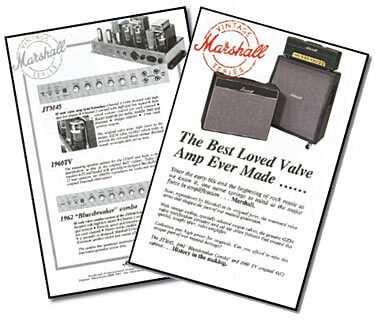
The Marshall ads above suggested the reissues matched the originals; in reality, there were significant differences.
Marshall cabinets were also visually appealing and had the look of richly appointed furniture. Black PVC (polyvinyl chloride) material, similar to the General Tire invention known as “Tolex,” was used for the entire exterior of the cabinet. This smooth, black fabric was different from the black “Levant” Tolex Marshall would use later.
Accenting the cabinets was Marshall’s elegant grill cloth. The company’s catalogue referred to this early cloth only as, “contrasting speaker grills,” not actually describing the color or pattern of the cloth material. However, it was known as the “white” grill cloth and had thin, horizontal gray lines running through it. Also included on the earliest models were three leather straps, attached to the top of the cabinet and similar to the Vox AC30. These amplifiers weighed in at a very heavy 70 pounds, and the sheer weight meant that it wasn’t long before the leather straps would stretch and break. In early 1965, an improved, single plastic strap which was stronger and larger in size replaced the leather ones.
The very first Marshall combos produced in late 1964 used what was known as “Vox-style” cooling vents, which allowed the heat produced by the transformers and vacuum tubes to escape efficiently. Two vents were installed into the top of the cabinet, similar to the Vox AC30. The vents were rectangular in shape and had a metal screen riveted inside.
Chassis Electronics and Components
The internal chassis that included all the electrical components was made of 6061 aluminum sheet metal. Aluminum has excellent non-sparking and non-magnetic characteristics, making it ideal for electrical shielding purposes and chassis use. It is, however, not as strong as steel and would fatigue and sag under the weight of the heavy power and output transformers. To remedy this, cast aluminum end blocks were riveted inside each end of the chassis to add strength and rigidity. The chassis were 2.5″ deep and purchased from a sub-contractor named Smiths.
The JTM45 used one circuit board screwed inside the aluminum chassis, providing a central platform for the various electrical components. Prior to 1965, Marshall used Tufnell perforated circuit boards; from 1965 to 1967 a subcontractor called Heathfield manufactured the circuit boards, which can be recognized by the drilled holes on the solid sheets.
The output transformer was officially known by Marshall as the “RS De Luxe.” It was light gray in color, with horseshoe end bells. The maximum output rating was only 30 watts, and all three transformers used on the JTM45 — the output, power and choke — were purchased from Radiospares, an electrical component clearing house.
The first combos produced in late 1964 were equipped with two GEC (General Electric Co.) KT66 vacuum tubes. The original design of the JTM45 called for the Tung-Sol 5881 tube; because this tube was used in the Fender Bassman, it was the tube of choice. However, supplies for the 5881 were scarce and the KT66 was used as a replacement. The KT66 provided more bite and distortion, suiting the JTM45 perfectly, and unlike the EL34, it was not overly saturated and did not sound mushy. The KT66’s bottom end was solid and exhibited clarity, while the trebles were almost “violinlike” in nature and very smooth. Much like the Fender Bassman, the JTM45 became known for its unique sound, primarily because of this tube.
Four 12AX7 (designated the ECC83 in Europe) preamp tubes were supplied in the 1961 and 1962, and both featured a tremolo circuit as a standard appointment. These amps also included tube rectification, which added to the sound’s overall smoothness. The 5AR4 rectifier tube (designated the GZ34 in Europe) was used on all JTM45 configurations, including models 1961 and 1962, and was the same rectifier used in the Fender Bassman and many other classic American amplifiers.
The JTM45 also incorporated two “can” style filter capacitors; the number of capacitors used, and their respective value, was a significant factor in the overall sound of the amplifier. One LCR Co. 32ìf x 32ìf at 450 volts was mounted on top of chassis near the power transformer, and one LCR Co. 16ìf x 16ìf at 450 volts was mounted inside the chassis just beneath the power transformer — the standard arrangement for the JTM45.
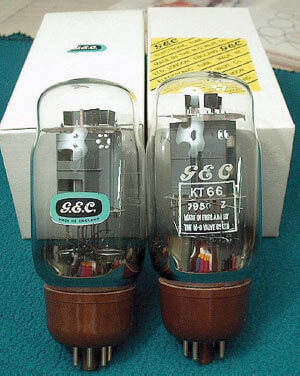
KT66 tubes as were used in Clapton’s Model 1962.
Speakers & Logo
The Model 1961 would utilize four 10″ Celestion Alnico speakers, while the Model 1962 would use two 12″ Celestion G12 speakers, handling 15 watts and featuring an Alnico magnet. The Alnico magnet contributed to the amp’s unique and sparkling sound, referred to as the “British chime.” A basic style of logo badge was used on these very first combos, and is commonly referred to as the “gold block logo.” The badge was rectangular in shape and was very simple, having only the Marshall name in bold block letters. The letters were black in color on a background of gold, although silver was sometimes used.
The Clapton-Spec Combo — One of a Kind?
The particular Model 1962 amplifier that Eric Clapton used with John Mayall and the Bluesbreakers was unfortunately lost, without knowing its exact pedigree. It was definitely an early edition of the Series II combo and was built during a continuous procession of production changes and revisions. The typical production run of any of the Marshall line could have differing components from amp to amp — it is not an exaggeration to say no two amps were exactly alike. This was primarily due to the inconsistent component suppliers Marshall used at the time, and partly because booming business made record keeping (serial numbers, production quantities, etc.) a low priority — existing serial numbers are not reliable or even logical, and production numbers are at best derived from employee recollections. Therefore, determining just how many amps were built exactly like Clapton’s is extremely difficult. The following list of features, derived from exhaustive research, best represents the Clapton’s combo specs. This particular amp is pictured on the reverse side of the “Beano” LP. The Series II cabinet was designed by Marshall’s chief designer Ken Bran, and incorporated a more modernistic styling. Its dimensions were 32″ wide by 23″ high by 10.5″ deep. The cabinet was sturdy and constructed of 3/4″ marine ply, incorporating one slot-style cooling vent and covered with black Lavent vinyl. The grill cloth was the classic gray and white striped variety later known as “Bluesbreaker” grill cloth. The cabinet was smartly accented with gold hardware attachments for the cabinet handle.
Chassis Electronics and Components
Clapton’s amplifier utilized the JTM45 bass guitar amplifier electronics known as the Model 1986 and the same chassis used in the Series I, made of 6061 aluminum sheet. One circuit board screwed inside the aluminum chassis was used and it was manufactured by the Heathfield Company.
Mounted on top of the chassis was the heart of the amplifier — the transformer. The defacto JTM45 output transformer was the “RS De Luxe;” however, since it was rated at only 30 watts, it was not ideal. Clapton’s amp may have utilized the newly acquired Drake Companytransformers. The output transformer would have been Model #784-103, with an 8K primary Z, and the power transformer would have been Model #1202-55. Utilizing the Drake transformers would explain why Clapton’s combo did not sound like a “typical” JTM45amplifier.
Clapton’s amplifier utilized two GEC KT66 output vacuum tubes. The preamp circuit included four Mullard ECC83 tubes, with one dedicated to the tremolo circuit. The Mullard GZ34 rectifier tube was again used. Two can-type filter capacitors were used: one LCR 32ìf x 32ìf at 600 volts mounted on top of the chassis near the output transformer, and a second LCR 16ìf x 16ìf at 450 volts mounted inside the chassis.
Speakers
The amp’s speakers consisted of two 12″ Celestion G12s, rated at 20 watts, 15 ohms, and with an Alnico magnet. These speakers were essentially the same as those used in Vox AC30s, and are extremely fragile when pushed beyond their limit. Because Clapton ran the amplifier at full volume, the Alnicos may have been damaged. He may have replaced them with the higher wattage, ceramic magnet Celestion Greenbacks.

The Model 1962 reissue schematic.
The Objective: Convert a Reissue to Clapton-Spec
I started my investigation into obtaining this sound over 20 years ago. In addition to the “Beano” studio CD, there were other John Mayall albums that included “live” cuts from Eric Clapton’s time with the Bluesbreakers. Although these recordings were done with crude equipment, they captured the raw and unrestrained sound of Clapton’s guitar and amplifier. To my ears, these recordings were most realistic, as they lacked any studio treatment. I quickly knew what sound I was after.
In 1994, Mike Doyle’s book, The History of Marshall, was released and included an eye-opening chapter on the Bluesbreaker. That chapter confirmed the reissue’s lack of authentic sound, and it became obvious that in the amp’s conversion to Clapton specs the only salvageable pieces would be the electrical chassis, the control panel and some of the cabinet hardware — the cabinet and speakers would have to be replaced.
With that, I decided to do the conversion in a logical progression and planned to document the progress. I preferred a progressive approach, as it would give me a chance to analyze each change made separately. In addition, since this conversion would be fairly expensive, it would be easier on the budget to purchase items over a period of time. The changes required could be grouped into three categories:
I should note that it is possible to make deeper changes, such as replacement of the circuit board, resistors, potentiometers and components, plastic tube sockets, and rewiring of the chassis to original specifications. These additions will make the electronics of the amplifier more authentic, but will not noticeably improve the sound. These additions also significantly increase the cost and add more time to the project.
The steps I have outlined above will reproduce the amplifier tone as heard on the live cuts of Clapton with the Bluesbreakers, as well as the “Beano” record. In fact, after making these changes, your Bluesbreaker will no longer be a mere reissue — it will sound like the real thing!
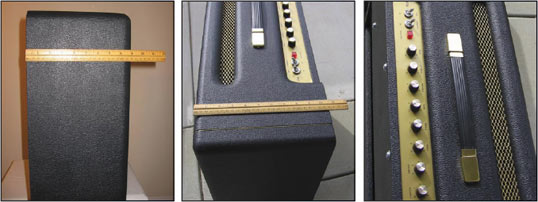
The new cabinet is over 2″ bigger than the reissue cabinet, resulting in a fuller sound.
Step 1: A Bigger Cabinet
There are now several competent amplifier cabinet makers building exact replicas of the Model 1962 Series I and II cabinets. Be sure these makers use the required multi-ply Baltic birch plywood, correct black Tolex covering, vintage gold veining and the surrounding white piping. It is also wise to have them confirm the correct cabinet dimensions, as the Series I and II are two completely different cabinets. To save some money, you could use the Marshall logo, casters and other hardware from your existing reissue. Two excellent cabinet makers available on the internet are Vibroworld.com and Swansoncabinets.com.
For the first phase, I ordered a new cabinet from a cabinet maker on the internet — to ensure accuracy, I supplied them with a CAD drawing of the Series II dimensions and features. I was very pleased with the results I received a few weeks later. I removed the chassis and speakers from my Marshall reissue and reinstalled them in the new cabinet. Even though the new cabinet included pre-drilled holes and Tnuts for the speakers, it still took some time to make this switch. While switching cabinets, be careful to ensure the speaker and amplifier connections are right.
For testing, I used a Gibson Les Paul Heritage 80 model. After re-checking the chassis and cabinet connections, I turned on the amplifier, and let it warm up. I started at low volumes and progressively turned up the volume to 10, all while keeping the other settings such as presence, bass, middle and treble at 10. Upon hearing the first chords, I was immediately struck by a new “openness.” The amplifier seemed to breathe and had a new, airy sound to it — it did not sound as tight as the smaller reissue cabinet. With 30 percent more space in the cabinet than the reissue, the trebles seemed revived and the amp now had an “airy” bottom-end. Comparative testing with another stock Bluesbreaker reissue verified the tonal improvements.
An interesting side note; in 1997, Marshall produced a limited edition white Bluesbreaker called the “Limited Edition 1997.” It was basically was the same amplifier as the 1989 reissue, with one important difference: the limited edition’s cabinet incorporated the deeper 10.5″ thickness, as can be found in the original Model 1962 Series II.
Step 2: The Electronics
Before digging into the guts of the Bluesbreaker, a word of caution: this phase deals with potentially dangerous electrical voltages and it is highly recommended that only a trained and competent amplifier repair person or skilled electrician perform these tasks.
This phase involves swapping out the reissue transformer, changing the 6L6 vacuum tubes to KT66s, and replacing the filter capacitors.
The Transformers and Tubes
There are now some good vintage transformer manufacturers around, so one has a choice in the matter. Since the original Model 1962 used a Radiospares (RS Deluxe) transformer, the objective here is to get one like it. When I did my conversion, I purchased a Mercury Magnetics Model O45RSL-8-M(MercuryMagnetics.com).
When it comes to power tubes, the only one to use here is the revered KT66. There are however, a few brand options available. One could either purchase a matched set (two are needed) of original GECs, or purchase a pair from companies offering reissue KT66s. The European and American tubes manufactured in the 1950s and 60s (new old stock) are superior in tone, quality and reliability. Tubes now manufactured in Russia and China such as Groove Tubes, the new Tung-Sol, and JJ/Tesla offer comparable tone and are reasonably priced. Since these tubes are made overseas, it is difficult to isolate a superior brand, and although tonal quality is improving with better consistency, tone remains an individual choice. For my conversion I used a matched set of Chinese Valve Art tubes, and was not disappointed.
Since we are changing out the power tubes, it is highly recommended to replace the 12AX7 (ECC83) preamp tubes as well. Again, there are several good options here which include SED Winged “C,” Electro-Harmonix and Ei/Ei-Elites. Replacing the GZ34 (5AR4) rectifier tube is also a must for optimum performance. The same tube suppliers listed above carry the GZ34, in varieties like Sino, Sovtek, or the very expensive Phillips metal base.
Filter Capacitors
Replacing the big can-style filter capacitors will definitely give your reissue more clarity. Filter capacitors are rated in the ZZxZZ format. The reissue Bluesbreaker has two 50×50ìF capacitors which must be replaced. The blue 50×50ìF filter capacitor, located closest to the GZ34 rectifier tube should be replaced with a 32×32ìF/600V capacitor. The other 50×50ìF gets replaced with a 16×16ìF/450V capacitor. JJ and F&T are two good options for filter capacitors.
Caution: These changes should only be done by a good amplifier repairperson. Also remember to have your KT66 vacuum tubes rebiased. I had renowned Bluesbreaker guru Ted Breaux finalize and tune my Bluesbreaker electronics.
Before using the amp at full volume, a suitable warm-up for the newly installed electronics should be done by simply powering up the amp and leaving it on Standby for a good hour or so. While it’s warming up, pay close attention to any unusual odors or burning, as a bad solder joint or incorrect wiring could cause a short circuit.
Once the amp has warmed up, with no guitar plugged in set the Presence, Bass, Middle and Treble controls to 10. Then start increasing the volume of Input 1 slowly, listening for any peculiar pops or sizzling noises in the process. If you don’t hear or notice anything unusual, you should be set to go.
For the “sound” test I used the same Gibson Les Paul Heritage 80; for the tonal comparison, I used the Primal Solos CD, starting with the solo in “It Hurts to Be In Love.” Before cranking the amp to 10, I employed the same gradual progression of low volume checks, listening for any unusual noises and so on. When I got to 10, I was astounded!
I was able to produce the same overtones and harmonics as the recording.
Likewise, the treble response was spectacular. I had read that Clapton used a Rangemaster treble booster with his amp, but I was getting the “sound” without one. The F9 chord in “Have You Ever Loved a Woman” shimmered and went into harmonic overload, exactly like the recording. The only notable difference was in the bass registers, as it seemed harsh at times and slightly lacking in tightness — additionally, some of the treble response seemed a little harsh. But I was definitely hearing 95 percent of that Clapton-spec sound, as no EL34 or 6L6 had ever sounded like this. It was now time for a speaker change.

The cabinet after installing the Weber Blue Dogs.
Step 3: The Speakers
I narrowed my choice of Alnico speakers down to the Celestion G12 Alnico Blues and the Weber P12B Blue Dogs. The Celestions were rated at 15 watts while the Webers were rated at 30 watts — I decided to try the higher-wattage Weber P12B. After swapping out the reissue Greenbacks for the new Blue Dogs, I played the amp at lower volumes for several hours. At these levels (5-6), I was pleasantly introduced to the British chime of the 1960s. Early Beatles rhythm and lead guitar sounds were easily obtainable, particularly within the mid and bass ranges.
I then tried the full throttle test. At full volume, I was in for quite a shock — the mid and bass ranges nearly cut me off at the knees. The treble side was knife-edge harsh and the amp was monstrously louder. I was obviously disappointed, as none of this remotely sounded like a Bluesbreaker. I had read that Alnico speakers may require an extended “break-in” period, and I hoped that was the case here.
I removed the Blue Dogs from the Bluesbreaker cabinet and reinstalled them into a 2×12 cabinet I was using for weekend gigs. After a few weekends of extended playing, I noticed the sound changing, as I was having to re-adjust my amp head settings. After a few more weekends, I definitely noticed something happening. It was now time to re-install the Blue Dogs back into the Bluesbreaker cabinet.
Upon trying it again, something magical happened to the overall sound of the amplifier. Right there in my basement, and out of my rebuilt Bluesbreaker, came the sound. I was flabbergasted, as it sounded incredible. I must have played the amp all night. I was nailing all of Clapton’s Bluesbreaker riffs, and they sounded identical to recordings. The A minor solo break in “All Your Love” sounded amazing, and like the recording, it was drenched in sustain and overtones. “Stormy Monday” from Looking Back was spot on.
Finally, my Bluesbreaker renovation was complete. The amp sounded just like it should, some 40 years ago. Doing this yourself makes all the difference, as you become a part of the equation — with a little work and dedication, you can experience Marshall just as Clapton discovered it.
Source: https://mercurymagnetics.com/pages/news/PremierGuitar/PremierG-08.htm